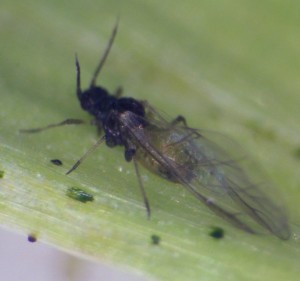Corn leaf aphid
 Scientific Name
Scientific Name
Rhopalosiphum maidis
Hosts
The corn leaf aphid shows a preference for barley, sorghum, and corn, in that order. It also infests many other wild and cultivated grasses. An occasional pest of winter wheat, and sometimes occurs on seedling wheat in the fall. It is a vector of Barley Yellow Dwarf virus.
Damage
 Feeding by colonies of these aphids causes mottling and discoloration of leaves. Heavily
infested leaves turn red or yellow, shrivel, and die. The important damage usually
occurs during and after flowering. At this time the aphid population peaks and feeds
on corn tassels and silks. Areas fed upon become covered with sweet, sticky honeydew
secretions. Black mold grows on the honeydew and may result in poor corn pollination,
interference with photosynthesis and, in severe cases, reduced grain development.
Feeding by colonies of these aphids causes mottling and discoloration of leaves. Heavily
infested leaves turn red or yellow, shrivel, and die. The important damage usually
occurs during and after flowering. At this time the aphid population peaks and feeds
on corn tassels and silks. Areas fed upon become covered with sweet, sticky honeydew
secretions. Black mold grows on the honeydew and may result in poor corn pollination,
interference with photosynthesis and, in severe cases, reduced grain development.
Life Cycle
The first spring adults are winged females which fly in search of suitable host plants. Shortly thereafter, they give birth to live nymphs which usually develop into wingless females. Under favorable conditions, more winged females develop and migrate. Males are rarely found but females continue to reproduce without mating. No egg stage is known. Reproduction slows down in winter and summer and is most rapid during cool weather. Therefore, corn leaf aphids tend to be a problem on winter grains in spring and on late-planted corn in fall. The number of generations per year varies from 9 in Illinois to 50 in southern Texas.
Description
The oval wingless adult is approx. 2 mm long, pale bluish-green with black antennae, legs, and cornicles and a dark area around the base of the cornicles. The head is marked with two longitudinal dark bands, and the abdomen with a row of black spots on each side. The body often seems to have a powdery coating. The winged form is about the same size.
Control
Please contact your local county extension office for current information.

